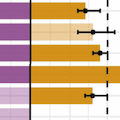Abstract
Importance: Few US studies have reexamined risk factors for SARS-CoV-2 positivity in the context of widespread vaccination and new variants or considered risk factors for cocirculating endemic viruses, such as rhinovirus.
Objectives: To evaluate how risk factors and symptoms associated with SARS-CoV-2 test positivity changed over the course of the pandemic and to compare these with the risk factors associated with rhinovirus test positivity.
Design, Setting, and Participants: This case-control study used a test-negative design with multivariable logistic regression to assess associations between SARS-CoV-2 and rhinovirus test positivity and self-reported demographic and symptom variables over a 25-month period. The study was conducted among symptomatic individuals of all ages enrolled in a cross-sectional community surveillance study in King County, Washington, from June 2020 to July 2022.
Exposures: Self-reported data for 15 demographic and health behavior variables and 16 symptoms.
Main Outcomes and Measures: Reverse transcription–polymerase chain reaction–confirmed SARS-CoV-2 or rhinovirus infection.
Results: Analyses included data from 23,498 individuals. The median (IQR) age of participants was 34.33 (22.42-45.08) years, 13 878 (59.06%) were female, 4018 (17.10%) identified as Asian, 654 (2.78%) identified as Black, and 2193 (9.33%) identified as Hispanic. Close contact with an individual with SARS-CoV-2 (adjusted odds ratio [aOR], 3.89; 95% CI, 3.34-4.57) and loss of smell or taste (aOR, 3.49; 95% CI, 2.77-4.41) were the variables most associated with SARS-CoV-2 test positivity, but both attenuated during the Omicron period. Contact with a vaccinated individual with SARS-CoV-2 (aOR, 2.03; 95% CI, 1.56-2.79) was associated with lower odds of testing positive than contact with an unvaccinated individual with SARS-CoV-2 (aOR, 4.04; 95% CI, 2.39-7.23). Sore throat was associated with Omicron infection (aOR, 2.27; 95% CI, 1.68-3.20) but not Delta infection. Vaccine effectiveness for participants fully vaccinated with a booster dose was 93% (95% CI, 73%-100%) for Delta, but not significant for Omicron. Variables associated with rhinovirus test positivity included being younger than 12 years (aOR, 3.92; 95% CI, 3.42-4.51) and experiencing a runny or stuffy nose (aOR, 4.58; 95% CI, 4.07-5.21). Black race, residing in south King County, and households with 5 or more people were significantly associated with both SARS-CoV-2 and rhinovirus test positivity.
Conclusions and Relevance: In this case-control study of 23,498 symptomatic individuals, estimated risk factors and symptoms associated with SARS-CoV-2 infection changed over time. There was a shift in reported symptoms between the Delta and Omicron variants as well as reductions in the protection provided by vaccines. Racial and sociodemographic disparities persisted in the third year of SARS-CoV-2 circulation and were also present in rhinovirus infection. Trends in testing behavior and availability may influence these results.
